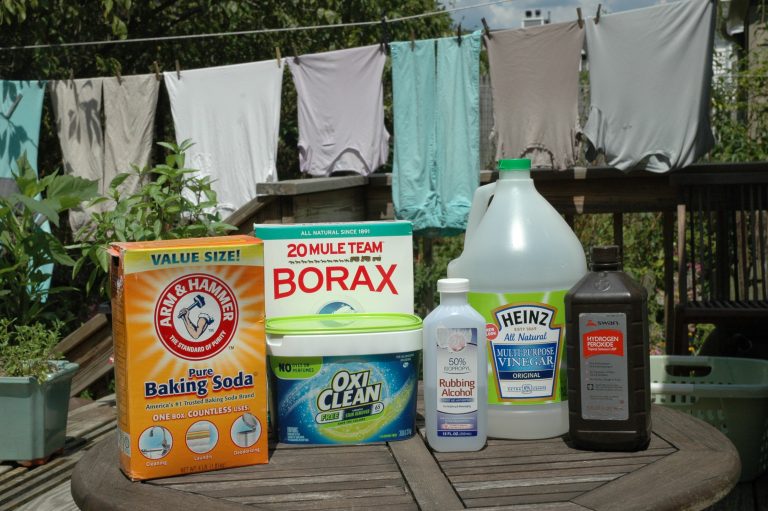It seems incredible how many different ways one can ruin a piece of clothing. Aside from physical wear and tear, our garments face daily threats of stubborn stains in the home, office, and outdoors — even at the beach! Most of these don’t need to be permanent, but it is important to use the correct method for removal, as different types of stains require different treatment.
While many cleaning products boast stain-removal prowess, they often come at the expense of our health. Exposure to even small amounts of harsh and toxic chemicals can have a negative impact over time. Here we will explore effective natural solutions for a variety of stains on fabric. Some of your key allies in this battle will be baking soda, vinegar, hydrogen peroxide and sunshine.
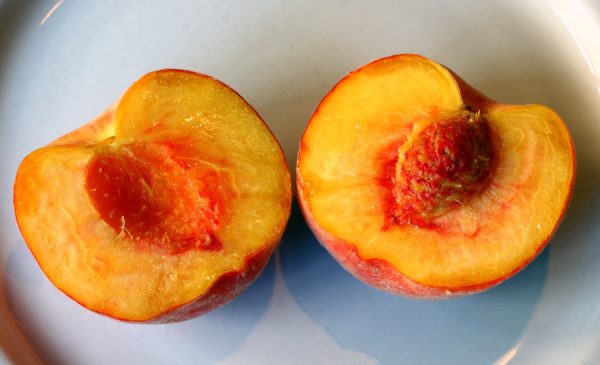
Fruits, berries and tomatoes
Summer is a great time to enjoy fresh, ripe fruit; but it is often so deliciously juicy that it’s hard to avoid dribbles on our clothes. These acidic stains dissolve readily in a stronger acid — namely vinegar, or lemon juice.
A fresh blemish is easily treated by dousing the stain with white vinegar. To prevent acid damage to your clothing, rinse promptly after five minutes. If the stain has set, however, it requires a little more work.
A paste of 3:1 borax and baking soda can be applied directly and copiously to the stain. As it dries, it will absorb much of the discoloration, so let it sit for at least 15 minutes. Rinse the paste off in lukewarm water, then apply your normal laundry liquid or dish soap to the stain. Soak the whole garment in a tub of hot water with a half scoop of OxiClean (fully dissolved) or a cup of hydrogen peroxide (not recommended for colored fabric), then wash as normal.
Success
You are now signed up for our newsletter
Success
Check your email to complete sign up
OxiClean is an oxidizing product that, when dissolved in water, breaks down into oxygen and soda ash. It is considered safe for the environment and for a wide range of materials.
Any remaining discoloration can be bleached out naturally by hanging your clothes out on a line, while a cycle in a heated dryer will make it more impossible to remove.
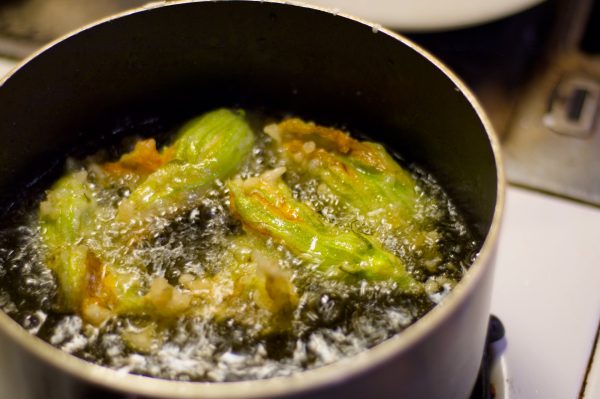
Oil and grease
Kitchen splatters and greasy food slipping out of greasy fingers can make a mess out of a nice top; but they aren’t impossible to remove. Common household products like shampoo and dish soap are designed to remove oils and do a good job on fabrics as well. Choose brands with natural surfactants and no added dyes or chemical fragrances for your own benefit, and to prevent additional issues with your clothing.
If you catch the spill right away, rubbing the spot with one of these before laundering may be sufficient to prevent a stain. If the garment has already gone through a wash/dry cycle, it will be more difficult but not impossible.
First sprinkle the stain with baking soda. Gently work the powder into the stain with an old toothbrush to help absorb excess oils. Then saturate the stain with vinegar to acidify the area, making it easier for the alkaline shampoo or dish soap to remove the stain.

Sunscreen
One may rightly wonder why a white sunscreen would cause an orange stain that seems impossible to remove. The mineral compounds that help block the sun are what cause this unusual discoloration in fabric, and the oily ingredients used for application heighten the stain and cause difficulties in removing it. This makes sunscreen a combination stain.
Avobenzone is a dibenzoyl methane derivative that is commonly used in sunblocks, since it absorbs ultraviolet light. This chemical tends to oxidize in water, creating something like a rust stain. Chlorine and oxygen bleach also react with avobenzone to worsen the stain.
This can be naturally treated with lemon juice and salt. Avoid soaking the garment, but when you are ready to treat the stain, flush it with water and lie it flat on a surface suitable for overnight exposure to dampness.
Saturate the stain in lemon juice, and then cover it in salt. Allow them to penetrate the stain overnight. In the morning, remove the salt and launder as usual.
To prevent avobenzone stains, use zinc-based protection instead.
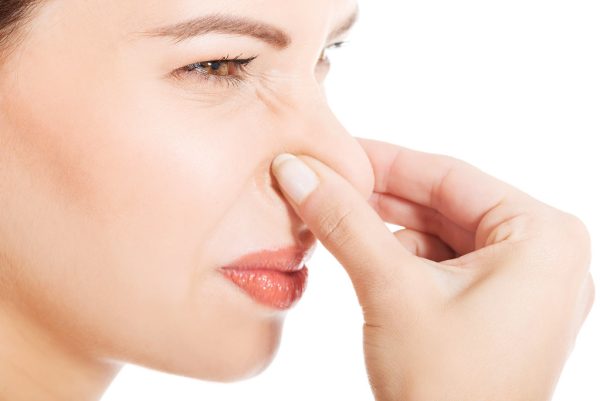
Sweat stains and dingy whites
Sweat stains are not actually caused by sweat. The discoloration is caused by a chemical reaction between sweat and the things it comes into contact with. Oddly enough, antiperspirant can contribute to sweat stains, just as bleach can cause a progressive yellowing of white fabrics.
As with many staining agents, sweat marks can be easily removed if caught right away. Before the sweat dries, wet the soiled area with cold water, rub the fabric to work out the sweat, and rinse thoroughly before laundering as usual. Once the stain is set, the job of removal is more difficult, but worth the effort if it saves a favorite shirt.
Make enough 2:1 solution of water and vinegar to completely immerse your garment. Allow it to soak for up to 30 minutes. For colored fabrics, rub the stained area and rinse with cold water. If the stain persists, soak the whole garment in an oxiclean solution as described under “Fruits, berries and tomatoes.” This will also eliminate odors.
For whites, after the water/vinegar solution, apply a paste of hydrogen peroxide, baking soda and salt directly to the stain and let it sit for 20 minutes. Then launder as usual.
Soak dingy whites in a tub with a full scoop of OxiClean dissolved in hot water, or a 1:1 mix of hydrogen peroxide and water for 30 minutes. Wash without bleach, and hang in the sun to dry for enhanced whitening.

Chocolate, coffee, tea and other tannins
Chocolate is another combination stain (consisting of fats, proteins and tannins) that can be tackled with natural ingredients. First you’ll want to remove excess chocolate from the fabric. Chilling the garment for 15 minutes and scraping from the perimeter towards the center can help prevent further spreading of the stain.
Tannins are found in many foods and beverages like coffee, tea and red wine. The brown stain they leave on clothing can be removed by saturating the stain with a 1:1 solution of vinegar and water; let it sit for 10 minutes and wash with an enzyme-based laundry detergent. Alternatively, hydrogen peroxide is safe for whites, and can be used in a 2:1 ratio with dish soap to directly treat the stain for 10 minutes before washing.
Coffee and tea are simpler stains that can be avoided by flushing the fresh spill immediately with hot water. If the stain is set, apply the vinegar treatment, rub, and wash as normal.
Again, hanging your laundry out to dry will take advantage of the sun’s natural power to fade stains.
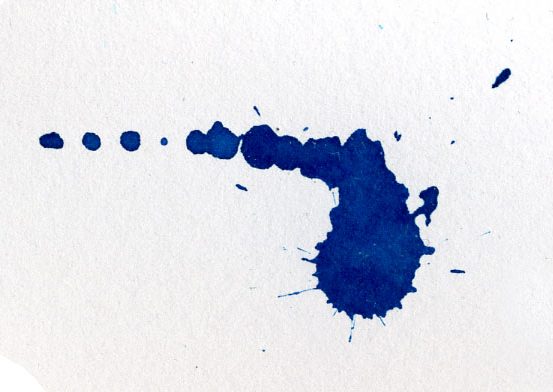
Ink stains
Depending on the type of ink, you may have another combination stain. The typical ball-point pen uses an oil-based ink, which can be removed with rubbing alcohol, a solvent found in both hair spray and hand-sanitizer.
Place the soiled layer of clothing over an old towel or and saturate the stain with some form of rubbing alcohol. After about five minutes, blot the stain with a clean cloth by pressing into the towel. Reapply the solvent until the stain fades. Apply a bit of clear dish soap and launder as usual.
Fountain pens, gel pens, and washable markers use water-based ink which, amazingly enough, can be removed with milk!
Soak the stained portion in a bowl of milk for one hour, then scrub with an old toothbrush and rinse in warm water. Rinse in warm water and apply a bit of dish soap to the remaining discoloration. After one hour, launder as usual and hang it out to dry.
The most difficult ink stains are alcohol-based, or those used in permanent markers. Again, rubbing alcohol will be your main tool, but you may need to treat it several times to see improvement. A treatment with dish soap and soaking in oxiclean solution may be necessary as well.

Grass and mud
Children should always be encouraged to get outside and play, but the results can be scary for the launderer. Outdoor stains like grass and mud are treated somewhat differently because of their nature.
Grass is another stain that can be treated with vinegar. Soak the stained area in a small bowl of vinegar for 30 minutes and rinse. This may take care of the stain entirely; but if not, you can apply a paste of baking soda and water, rub it in with a toothbrush, and let it sit 15 minutes before laundering as usual.
Mud is an anomaly in that it should be allowed to dry completely before trying to remove it. After that it can be scraped off without risk of spreading, shaken out, or even vacuumed. Treat the remaining stain with a liquid soap, rub both sides of the fabric every five minutes with a wet toothbrush to work it in for a total of 15 minutes.
If the stain is still obvious, soak the entire garment in an OxiClean solution for two to three hours before washing as normal. Hang out to dry to prevent fixing any remaining stain.
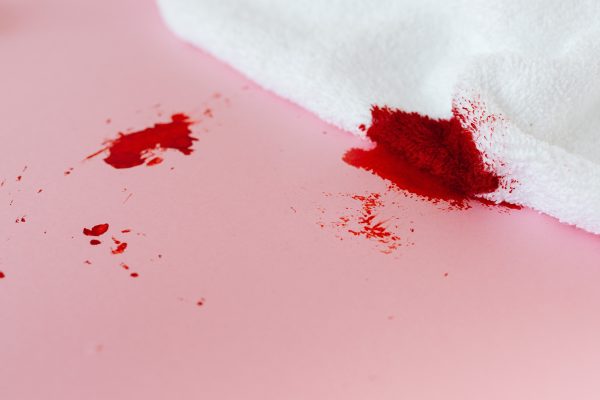
Blood and other proteins
Rinse fresh blood and other bodily excretions on clothing with cold water as soon as possible. Warm water will set a protein stain just as badly as letting it dry. If that has already happened, soak the garment in cold water for a couple of hours to loosen the stain, then agitate and flush with cool water to remove what you can.
Hydrogen peroxide can be applied directly to the remaining stain on white fabrics, and a bubbling action will show that the protein is being broken down by oxidation. Allow this to work for 10 to 15 minutes before washing on a cold cycle.
For colored garments, prepare a solution of OxiClean (above) and let it cool before immersing the stained item. Allow it to soak for an hour or more before washing on a cold cycle.
Hang to dry and repeat if necessary.
Sticky substances
Since the advent of home-made slime recipes, many of us have had to address the issue of sticky goo on everything from bedding and clothing to hair and carpets.
Sticky stains don’t have to be tricky. Adhesives are easily dissolved with oils. Products like peanut butter, hair conditioner, or vegetable oil will break down substances like chewing gum, pine sap, adhesive name tag labels, and even slime, which is fine when you get it in your hair…but you don’t want the oils to add additional stains to your clothing.
For sticky stains on clothes, rubbing alcohol is the simplest option. If there is a mass of the substance, freezing and scraping — see the chocolate pre-treatment above — is recommended. After that, dab the stain with an alcohol soaked cotton ball or Q-tip, depending on the size of the blemish.
In the case of chewing gum or slime, you may be able to work it off in one piece just by soaking the material side of the stain, thereby loosening its sticky grip. Once the sticky residue is removed, wash as normal. Slime may need additional treatment if it was colored with a dye; in which case, see the ink treatment above.
These treatments will work on most fabrics. To be safe, you should test a small inconspicuous area with the treatment to make sure it won’t cause further damage to your clothing.
Finally, and most importantly, a stain on your conscience can be a cumbersome burden that wears you down the longer you carry it. Whether you’ve been hurtful to yourself or others, offer a sincere apology and seek forgiveness. If you’ve done something you’re ashamed of, correcting your behavior is a step in the right direction. Forgive yourself for your flaws, as none of us is perfect, and strive to improve. A clean conscience will lighten your load and brighten your future.



